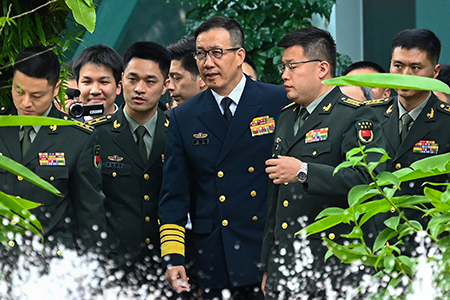“Right after I graduated, I interned with the Arms Control Association. It was terrific.”
The Security Paradox in China-U.S. Relations
September 2024
By Peter Burds
Chinese-U.S. nuclear tensions are approaching levels that have not been seen since the Cold War. Both countries’ miscalculated response stratagems are veering toward a “security paradox,” a downward spiral of self-perpetuating mutual hostility arising when myopic perceptions of antagonism and threat are read into a situation in which each party sought only defense and safety.1 This trend can be reversed only if China and the United States offset their reliance on strategic uncertainty by giving each other greater clarity regarding their intentions for modernizing their nuclear weapons arsenals and the conditions under which they would employ nuclear force.

To begin, China must base the conditions of its modernization and proliferation on concrete standards rather than on “minimum deterrence,” its blurred and ever-changing finish line. Second, the United States, if unwilling to adopt a universal no-first-use policy, must make clear at a minimum that the scope of its ambiguous defense agreement with Taiwan would not include first use of nuclear force as a response to Beijing intervening militarily on the island.2 Finally, the United States must change its fatalist nuclear logic, which unnecessarily labels defensively oriented states as military competitors. It also must alter its aim from developing capabilities to win a nuclear war to reaching a level of mutual vulnerability as is the only way to maintain global nuclear stability. Bilateral military-to-military meetings should serve as forums for these discussions.
The U.S. Department of Defense has reported that as of May 2023, China had more than 500 operational nuclear warheads and is expected to double that number by 2030.3 As a result, the Congressional Commission on the Strategic Posture of the United States called for “fully and urgently” modernizing the U.S. nuclear force, with the aim of upgrading to capabilities that are able to facilitate “[increased] reliance on nuclear weapons to deter or counter” and “defeat” hypothetical joint Chinese-Russian aggressions if conventional methods proved unsuccessful.4
Although these reports correctly identify the trend, narratives framing China’s nuclear development as evidence that the country is “less interested in coexistence and more interested in dominance” fail to address how such hegemonic bids fit within the greater scheme of its nuclear and national security policies.5 The defensive, no-first-use posture that China has held steadily since nuclearizing in 1964 shows that, rather than power, Chinese national security is built on mutual vulnerability and second-strike assurance. This is underpinned by a “lean but effective” principle of maintaining the minimum nuclear level necessary for deterrence, made possible by spreading quantitative and geographical uncertainty regarding China’s nuclear stockpile.6 This uncertainty, facilitated in part by an extensive network of tunnels, heightens the survivability rate of China’s arsenal by making it impossible for an attacking state to be certain that a first strike would successfully disarm China’s retaliatory capabilities.7
Uncertainty, therefore, is crucial to enabling China to maintain a comparably small nuclear stockpile, at a ratio of approximately 1:7 compared to the United States in 2024; keep its nuclear weapons on lowered day-to-day alert levels, thus lowering the risk of accidental launch,8 and lower the chance that nuclear force will be used against China in a preemptive attack. At the same time, the ever-changing and ambiguous standard determining China’s minimum level of deterrence stands out as problematic because it leaves states with no ability to forecast when this bar will be met and for how long. All that this phrase conveys is a rhetorical image of the arsenal’s effect, not any quantifiable truth.
As a result, China is able to change its subjective understanding of what minimum deterrence means numerically in light of any new, unexpected security dilemmas that may arise without having to change the rhetoric used publicly to discuss its nuclear stance. Such ambiguity is dangerous because the ability to predict future trends is essential for other parties to know how to respond proportionally to the security dilemma posed by China’s expanding arsenal.
Nonetheless, China always has made its no-first-use, retaliation-based nuclear policy explicitly clear. Leaders in Beijing see that this is the way through which bilateral confidence and stability are nurtured, by choosing doctrinal transparency over numerical transparency.9 The United States, on the other hand, leaves details regarding the circumstances under which it would employ nuclear weapons highly ambiguous, for example, “to protect U.S. vital interests.”10 Yet, Washington simultaneously makes clear that it reserves the right to use nuclear weapons first. The result is a dangerous information gap that sets the stage for the tensions faced today.

U.S. doctrinal uncertainty becomes especially relevant when considering the question of whether nuclear force falls within the scope of the ambiguous U.S. defense agreement with Taiwan.11 The strategic ambiguity that Washington pursues regarding its “One China” policy with Beijing must not bleed over to the context of nuclear use in the event of Beijing’s military intervention on the island. Up to this point, the unpredictability of what the U.S. reaction would be in this circumstance very likely has been a factor in preventing its occurrence.12 Yet, if China continues to modernize at its current rate, the risk of its successful retaliation following U.S. first use of nuclear weapons would be unacceptably high enough to cancel out such nuclear resort as a viable strategic option from the outset.
Furthermore, global and regional stability cannot be maintained through nuclear coercion. The United States must take the threat of nuclear confrontation out of the Taiwan equation by clarifying that it will not resort to first use of nuclear weapons in the island’s defense. This will open up paths for reaching a lasting solution through peaceful diplomatic means by removing the most volatile catalyst for nuclear competition and conflict in contemporary Chinese-U.S. relations. A Taiwan-specific no-first-use agreement would alleviate the worries of Washington’s East Asian allies by keeping the threat of nuclear escalation out of their backyards.13 Likewise, the specificity of this agreement would skirt issues impeding U.S. adoption of a universal no-first-use policy by allowing the United States to continue providing nuclear protection to these allies.
U.S. nuclear policy indicates that the country’s international relations are driven, as a general rule, by a fatalist logic, or what in lay terms could be called fear. In this paradigm, a country assumes that competition and conflict never can be escaped; hence, there is always an expectant fear of being attacked and of attacking. This mentality is evidenced further by the U.S. Department of State’s 2018 designation of China and Russia as long-term strategic competitors who want “to shape a world consistent with their authoritarian model.”14 Consequently, the U.S. approach to China’s nuclear modernization during the 2027 to 2035 threat environment is based around military preparedness rather than diplomacy and assumes a “worst is possible” security policy that makes it “impossible for defensively motivated states to communicate effectively to others their defence-only intentions.”15
This mindset is partly why the United States has difficulty accepting the nuclear stability paradigm of mutual vulnerability and instead pursues a nuclear arsenal able to “defeat” even joint Chinese-Russian attacks. As long as this policy is maintained, global nuclear polarity will suffer a dangerous imbalance that makes the possibility of unilateral nuclear use ever more likely. Mutual vulnerability is the reason that ballistic missile defense and Terminal High Altitude Area Defense systems deployed or upgraded by the United States in recent years have caused such controversy in Chinese-U.S. relations. Although the intentions behind and capabilities of these systems are up for debate, they could pose a serious threat to retaliation-oriented no-first-use states such as China by rendering the United States overly protected from reprisal if it were the first one to use nuclear force. China’s initial transition to multiple independently targetable reentry vehicle technology may have been a response to U.S. ballistic missile defense upsetting this polarity.16
Up to now, China and the United States have responded to growing tensions by taking steps to increase their own security, addressing nuclear modernization with nuclear modernization. Countermeasures have led to higher insecurity for the other side, stimulated similar countermeasures, and left the two parties with less security in the end.17 Despite this serious escalation, the two countries have not discussed nuclear arms control directly in any bilateral military meeting that has occurred since Chinese President Xi Jinping and U.S. President Joe Biden directed a resumption of these during their November 2023 summit.18 It is imperative that the two countries hold open-minded, detailed nuclear arms control discussions and swiftly put in place radical measures to reach a lasting solution that steers away from the grim security paradox now confronting them.
ENDNOTES
1. Ken Booth and Nicholas J. Wheeler, “Uncertainty,” in Security Studies: An Introduction, 3rd ed., ed. Paul D. Williams and Matt McDonald (New York: Routledge, 2018), p. 133.
2. U.S. first use of nuclear weapons involving conflict in Taiwan has been a serious source of Chinese concern. See Henrik Stålhane Hiim, M. Taylor Fravel, and Magnus Langset Trøan, “The Dynamics of an Entangled Security Dilemma,” International Security, Vol. 47, No. 4 (2023): 158-159.
3. U.S. Department of Defense, “Military and Security Developments Involving the People’s Republic of China, 2023: Annual Report to Congress,” n.d., p. viii, https://media.defense.gov/2023/Oct/19/2003323409/-1/-1/1/2023-MILITARY-AND-SECURITY-DEVELOPMENTS-INVOLVING-THE-PEOPLES-REPUBLIC-OF-CHINA.PDF.
4. Congressional Commission on the Strategic Posture of the United States, “America’s Strategic Posture,” October 2023, p. viii, https://www.ida.org//media/feature/publications/a/am/americas-strategic-posture/strategic-posture-commission-report.ashx.
5. “Biden’s New China Doctrine,” The Economist, July 17, 2021, https://www.economist.com/leaders/2021/07/17/bidens-new-china-doctrine.
6. Sun Xiangli, “The Development of Nuclear Weapons in China,” in Understanding Chinese Nuclear Thinking, ed. Tong Zhao and Li Bin (Washington: Carnegie Endowment for International Peace, 2016), p. 96.
7. 战略学 [The Science of Military Strategy] (军事科学出版社 [Beijing: Military Science Publishing House], 2013), p. 172.
8. Transition to a launch-on-warning system has not been confirmed, and the official status of China’s nuclear weapons remains offline. Gregory Kulacki and Robert Rust, “Xi Jinping’s Thoughts on China’s Nuclear Weapons,” Union of Concerned Scientists, April 1, 2024, https://blog.ucsusa.org/gregory-kulacki/xi-jinpings-thoughts-on-chinas-nuclear-weapons/.
9. Tong Zhao, “China’s Role in Reshaping the Global Nuclear Non-Proliferation Regime,” St Anthony’s International Review, Vol. 6, No. 2 (January 2011): 73.
10. Congressional Commission on the Strategic Posture of the United States, “America’s Strategic Posture,” p. 25.
11. Taiwan Relations Act, Pub. L. No. 96-8, 22 U.S.C. § 3301(b).
12. Richard Bush, “The United States Security Partnership With Taiwan,” Brookings Institute, n.d., https://www.brookings.edu/wpcontent/uploads/2016/11/fp_20160713_taiwan_alliance.pdf.
13. Tong Zhao, “It’s Time to Talk About No First Use,” Foreign Policy, November 6, 2023, https://foreignpolicy.com/2023/11/06/united-states-china-nuclear-meeting-no-first-use-arms-control/.
14. U.S. Department of Defense, “Summary of the 2018 National Defense Strategy of the United States of America,” n.d., p. 2, https://dod.defense.gov/Portals/1/Documents/pubs/2018-National-Defense-Strategy-Summary.pdf.
15. Booth and Wheeler, “Uncertainty,” p. 137.
16. Hans M. Kristensen and Robert S. Norris, “Chinese Nuclear Forces, 2016,” Bulletin of the Atomic Scientists, Vol. 72, No. 4 (2016): 207.
17. Oliver Kessler and Christopher Daase, “From Insecurity to Uncertainty: Risk and
the Paradox of Security Politics,” Alternatives, Vol. 33, No. 2 (2008): 215.
18. Three meetings occurred between December 2023 and May 2024.
Peter Burds is pursuing his master’s degree at the Johns Hopkins University-Nanjing University Center for Chinese and American Studies in Nanjing, China.
